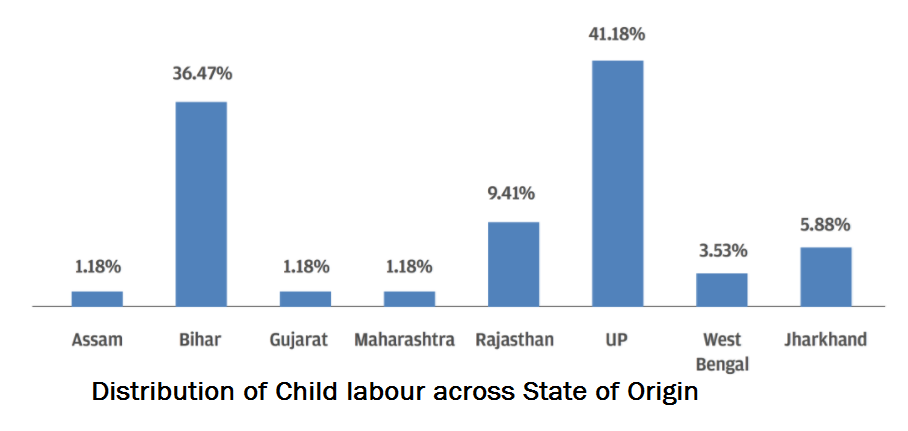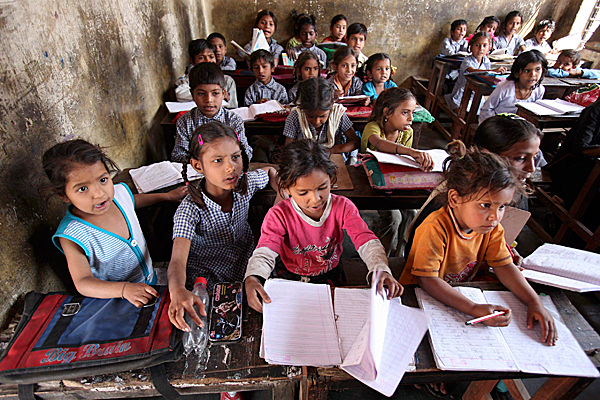Child Labour



About 1.4 million child labourers in India in the age group of 7-14 years can’t write their names. This means one in three child labourers in the said age group are illiterate. This is the grim reality of children who work for more than six months in a year. Even for children who support the family economy by working for less than six months in a year, which is very common in a country like India, the situation is equally, if not more, worse. A shocking 2 million of these marginal workers have compromised their education as well.
Combatting child labour requires long term co-ordinated action which involves many stakeholders and the government. This includes educational institutions, mass media, NGOs and community-based organizations as well as trade unions and employers. It is important that the attitudes and mindsets of people are changed to instead employ adults and allow all children to go to school and have the chance to learn, play and socialize as they should.
India’s 2011 census showed that: ·
- There were more than 10.2 million “economically active” children in the age group of five to 14 years – 5.6 million boys and 4.5 million girls, ·
- Eight million children were working in rural areas, and 2 million in urban areas, ·
- Although in rural settings the number of child workers reduced from 11 million to 8 million between the 2001 and 2011 censuses, over the same period, the number of children working in urban settings rose from 1.3 million to 2 million,
Education



The litercay ratio of India is 65.38% with male literacy at 75.85% and female literacy at 54.16% Of the 193 million Children in the age group 6 to 14 years, 8.1 million children are out of school as of Sept 2004 as per Government statistics.
- Net primary enrolment ratio in 2001/02 : 83 7%
- Children reaching grade 5 in 2000/01 : 59 8 %
Clearly, we have a lot to answer for. And as concerned citizens do something about it; something meaningful, something concrete, something urgently. No more do we have the luxury of blaming the system or postponing our actions. The time to take collective as well as individual responsibility to remedy the present situation is here. Right now! And also we need many more Smiles to cater to the vast (increasing) number of children in our country's population. Less than half of India's children between the age 6 and 14 go to school. A little over one-third of all children who enroll in grade one reach grade eight. At least 35 million children aged 6 - 14 years do not attend school. 53% of girls in the age group of 5 to 9 years are illiterate.
MalNutrition



India is facing a serious burden of under-nutrition, according to a global report released today which shows that more than half the women of reproductive age in the country suffer from anaemia. The Global Nutrition Report 2017, which looked at 140 countries including India, found ‘significant burdens’ of three important forms of malnutrition used as an indicator of broader trends. These include childhood stunting, anaemia in women of reproductive age, and overweight adult women. Hunger and undernourishment lead to severe problems. Malnutrition in children under-five also results in nearly half of the 1.3 million deaths occurring in the country each year. Among India’s adolescents, the proportion of overweight and obese was estimated at 11 percent and two percent, respectively, in 2007.[10] Data on anaemia show that 56 percent of young girls and 30 percent of young boys in the age group of 15-19 years are anaemic. Children and youth in this state suffer from numerous nutritional deficiencies which adversely impact their overall health. In India, data for 2015-16[7] show the following:
- 38 percent of children below five years (urban: 31%, rural: 41%) are stunted (low height for age)
- 21 percent (urban: 20%, rural: 22%) are wasted (low weight for height)
- 36 percent (urban: 29%, rural: 38%) are underweight (low weight for age)
- 2 percent were overweight in 2006[8] (above normal weight for height); and
- 58 percent of children aged between 6 and 59 months (urban: 56%, rural: 59%) are anaemic.
Poverty



At present, 28.5% of the Indian population lives below the poverty line.
In the category of poor falls the people whose daily income is less than 33 rupees a day in cities and 27 rupees a day in villages.
But do you think this amount is enough to survive even for a day in the country where every food item is available at sky-high prices?
This means, the actual number of people living below the poverty line is much higher, as according to the statistical data,
anyone earning 40 rupees won’t be considered as poor but must be facing the same difficulties in life.
Poverty in India – Statistics
- 50% of the population in India don’t have proper shelter
- India is home to one-third of the World’s poorest population
- 70% don’t have access to toilets
- 75 % of them live in rural areas
- 35% of households don’t have a clean nor near water source
- 85% of villages have no schools
Sexual Harrassment

India’s average rate of reported rape cases is about 6.3 per 100,000 of the population.
However, this masks vast geographical differences with places like Sikkim and Delhi
having rates of 30.3 and 22.5, respectively, while Tamil Nadu has a rate of less than one.
Of course, one must be careful in interpreting these state-wise differences as these are ‘reported’ cases and could suffer from under-reporting.
Even India’s average rate of 6.3, which is not very high when compared with the rest of the world, suffers from under-reporting.
According to a recent report by the Livemint, about 99% of cases of sexual violence go unreported. If true, this would put India
among the nations with highest levels of crimes against women.

WomenEmpowerment



Overall, the labour force participation rate for women is falling: from 37% in 2004-05 to 28% in 2016
- In 2015-2016, women comprised 26.7% of all rural workers, down from 31.8% in 1972-73.27
- In 2015-2016, women comprised 16.2% of all urban workers, a small increase from 13.4% in 1972-73.
- 13.4% of Indian working women have a regular salaried job (2013) compared to 21.2% (2011-2012) of working men (aged 15–59)
Delhi, Maharashtra and Gujarat, the high performing states in terms of economic and governance indicators, saw the sharpest decline in the given period. Delhi slipped from the sixth position to 16th, Maharashtra from 10 to 17 and Gujarat from 11 to 18. Most northeastern states climbed up the ladder. Two indicators for Delhi got worse: lesser proportion of women now participate in decision making as compared to a decade ago—figures falling from 84.8% in 2005-06 to 73.8% in 2015-16. Plus, a higher percentage of women (26.8%) reported having experienced spousal violence as compared to 16.3% in 2005-06. The star performer was Uttarakhand, jumping 13 positions: 24 in 2005-06 to 13 in 2005-16.